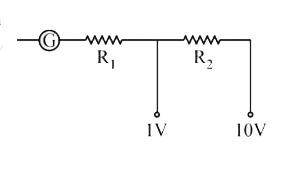The resistance of a galvanometer is 10Ω. It gives full-scale deflections when 1mA current is passed. The resistance connected in series for converting it into a voltmeter of 2.5V will be
24.9Ω
249Ω
2490Ω
24900Ω
The correct Answer is:C
To solve the problem of finding the resistance that needs to be connected in series with a galvanometer to convert it into a voltmeter, we can follow these steps:
1. Identify Given Values:
- Resistance of the galvanometer, G=10Ω
- Full-scale deflection current, IG=1mA=1×10−3A
- Maximum voltage to be measured, V=2.5V
2. Understand the Configuration:
- When converting a galvanometer into a voltmeter, a high resistance R is connected in series with the galvanometer. The total voltage across the combination should equal the maximum voltage V.
3. Use the Formula:
- The formula for the resistance R to be connected in series is given by:
R=VIG−G
- Here, VIG gives the total resistance needed to allow the full-scale deflection at the given voltage.
4. Calculate VIG:
- Substitute the values into the formula:
VIG=2.5V1×10−3A=2500Ω
5. Substitute into the Resistance Formula:
- Now substitute VIG and G into the formula for R:
R=2500Ω−10Ω=2490Ω
6. Conclusion:
- The resistance that needs to be connected in series with the galvanometer to convert it into a voltmeter of 2.5 V is:
R=2490Ω
Final Answer:
The resistance connected in series for converting the galvanometer into a voltmeter of 2.5 V will be 2490 Ω.
- Resistance of the galvanometer, G=10Ω
- Full-scale deflection current, IG=1mA=1×10−3A
- Maximum voltage to be measured, V=2.5V
- When converting a galvanometer into a voltmeter, a high resistance R is connected in series with the galvanometer. The total voltage across the combination should equal the maximum voltage V.
- The formula for the resistance R to be connected in series is given by:
R=VIG−G
- Here, VIG gives the total resistance needed to allow the full-scale deflection at the given voltage.
- Substitute the values into the formula:
VIG=2.5V1×10−3A=2500Ω
- Now substitute VIG and G into the formula for R:
R=2500Ω−10Ω=2490Ω
- The resistance that needs to be connected in series with the galvanometer to convert it into a voltmeter of 2.5 V is:
R=2490Ω
The resistance connected in series for converting the galvanometer into a voltmeter of 2.5 V will be 2490 Ω.
Topper's Solved these Questions
- BOOK - NCERT FINGERTPS ENGLISHCHAPTER - MOVING CHARGES AND MAGNETISM EXERCISE - HOTS5videos
MOVING CHARGES AND MAGNETISM
- BOOK - NCERT FINGERTPS ENGLISHCHAPTER - MOVING CHARGES AND MAGNETISM EXERCISE - EXEMPLAR PROBLEMS6videos
MOVING CHARGES AND MAGNETISM
- BOOK - NCERT FINGERTPS ENGLISHCHAPTER - MAGNETISM AND MATTER EXERCISE - NCERT Exemplar5videos
MAGNETISM AND MATTER
- BOOK - NCERT FINGERTPS ENGLISHCHAPTER - NUCLEIEXERCISE - Assertion And Reason15videos
NUCLEI
Similar Questions
The resistance of a moving coil galvanometer is 20Ω. It requires 0.01 A current for full - scale deflection. The value of resistance to convert it into a voltmeter of the range 20 V will be
View Solution100mA current gives a full scale deflection in a galvanometer of 2Ω resistance. The resistance connected with the galvanometer to convert it into a voltmeter to measure 5V is
View SolutionThe full scale deflection current of a galvanometer of resistance 1Ω is 5mA. How will you convert it into a voltmeter of range of 5V?
View SolutionIn full scale deflection current in galvanometer of 100ohm resistance is 1 mA. Resistance required in series to convert it into voltmeter of range 10 V.
View SolutionA galvanometer of resistance 1000Ω gives full-scale deflection for a current of 1mA. To measure a P.D of 10V, the resistance to be connected with the galvanometer is
View SolutionWhen a current of 5mA is passed through a galvanometer having a coil of resistance 15Ω, it shows full sacle deflection. The value of the resistance to be put in series with the galvanometer to convert it into a voltmeter of range 0−10V is:
View SolutionA moving coil galvanometer of resistance 20Ω gives a full scale deflection when a current of 1mA is passed through it. It is to be converted into an ammeter reading 20A on full scale. But the shunt of 0.005Ω only is available. What resistance should be connected in series with the galvanometer coil?
View SolutionA moving coil galvanometer of resistance 20Ω gives a full scale deflection when a current of 1mA is passed through it. It is to be converted into an ammeter reading 20A on full scale. But the shunt of 0.005Ω only is available. What resistance should be connected in series with the galvanometer coil?
View SolutionThe resisitance of a galvanometer is 50Ω and it shows full scale diflection for current of 1 mA. . To convert it into a voltmeter to measure 1V and as well as 10 V ( refer circuit diagram ) the resistance R1 and R2 respecivtively
 View Solution
View SolutionWhen 500μA curre nt is passed through a galvanometer of 20Ω , it gives a full scale deflection. The external resistance need to be connected to measure 5V is
View Solution

